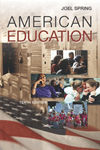 |
1 |  | 
The differences between the National Education Association and the American Federation of Teachers are a result of the regional differences between the North and the South. |
|  | A) | True |
|  | B) | False |
 |
 |
2 |  | 
The National Education Association has been influential in |
|  | A) | Shaping the modern high school |
|  | B) | Standardizing teacher training |
|  | C) | Discussing curriculum changes |
|  | D) | All of the above |
 |
 |
3 |  | 
The National Education Association became even more influential in shaping national educational policy after the passage of the National Defense Education Act in 1958. |
|  | A) | True |
|  | B) | False |
 |
 |
4 |  | 
Since the 1960s, the National Education Association has become more involved in |
|  | A) | Lobbying for legislation |
|  | B) | Collective bargaining |
|  | C) | Collective bargaining, political endorsement of candidates and lobbying for legislation. |
|  | D) | Political endorsement of candidates |
 |
 |
5 |  | 
Unlike the National Education Association, the American Federation of Teachers traces its origins to the labor struggles of teachers in Chicago. |
|  | A) | True |
|  | B) | False |
 |
 |
6 |  | 
In 1905, Margaret Haley commented that the teacher union's efforts were |
|  | A) | Sympathetic to the cause of labor unions, but unrelated to them. |
|  | B) | To create mutually supportive roles between teachers and organized labor. |
|  | C) | To be separate from organized labor due to the unique female characteristics of the teaching profession. |
|  | D) | Best led by the leaders of the labor unions because of their experience and expertise. |
 |
 |
7 |  | 
The American Federation of Teachers has always had a strike policy. |
|  | A) | True |
|  | B) | False |
 |
 |
8 |  | 
Today, both unions are involved in the educational issues of |
|  | A) | Standards, teacher training, charter schools, and teacher compensation. |
|  | B) | Standards, teacher training, and teacher compensation. |
|  | C) | Standards, teacher training, charter schools, advocating for national certification and teacher compensation. |
|  | D) | Standards, advocating national certification, charter schools, and teacher compensation. |
 |
 |
9 |  | 
The unions have adopted conflicting positions on the issue of |
|  | A) | Smaller class size. |
|  | B) | Standards. |
|  | C) | Charter schools. |
|  | D) | Higher salaries for teachers. |
 |
 |
10 |  | 
Teacher unions are primarily interested in the welfare of their members and in maintaining union power. |
|  | A) | True |
|  | B) | False |
 |




